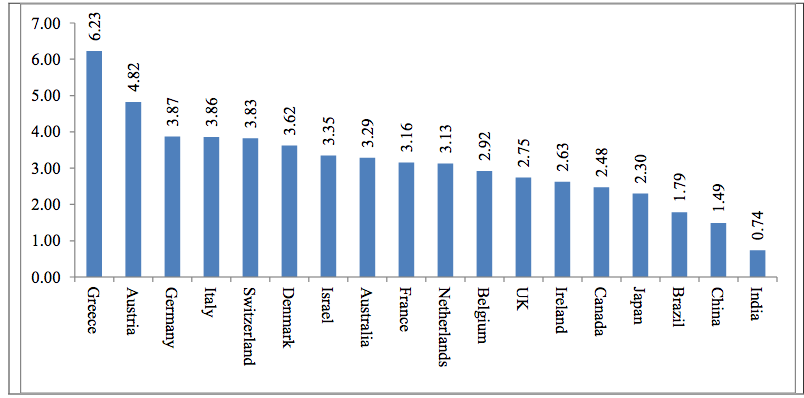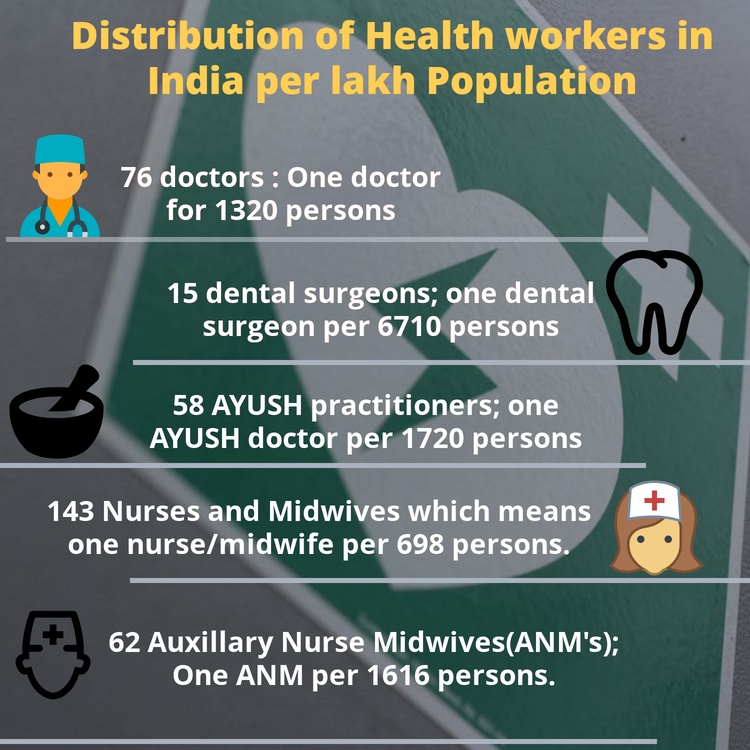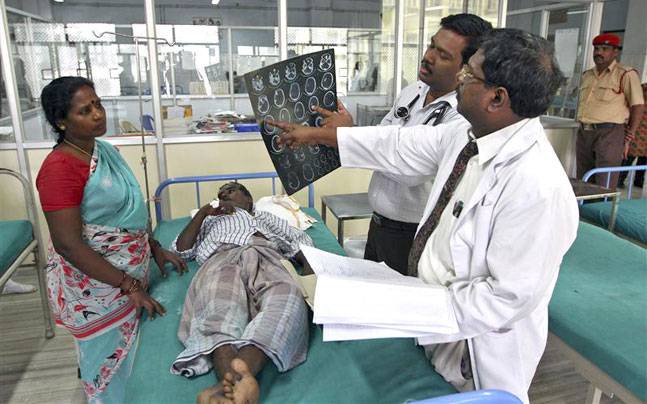“Overworked” doctor attempts suicide’.
This has been a news title that appeared in a media not so long ago. The title explains itself. The working condition of the health workforce in India. Timely, effective delivery of health services is much needed in the medical sector. Health workforce plays a major role in ensuring the proper functioning of the health system. The low workforce can affect the overall health care of a country. In order to achieve Universal Health Coverage, it is mandatory to overcome all the constraints.
Health Workforce in India: A brief overview
What does the term health workforce mean? Merely Doctors? No. Health workforce includes all those people engaged in actions whose primary aim is to enhance health. An adequately trained workforce is the backbone of an effective and efficient health care system. So to know who all comes under the broad genre of the workforce is important?
- Allopathic doctors who had completed their MBBS degree alone or an MBBS degree with a specialist degree or diploma.
- AYUSH Doctors who practice other treatment forms such as Ayurveda, Homeopathy, Unani, Siddha.
- Nurses
- Dentists
- Auxiliary Nurses and midwives who hold a diploma in auxiliary nursing and midwifery
- Community Health workers such as health educators and health assistants
- Accredited Social Health Activists (ASHA).
Since Indian health workforce includes even informal medical practitioners, reliable data regarding the number of health workers in India is hard to obtain. The main challenge is that several types of health workers offer health services in different systems of medicine.
Distribution of Health workforce in India.
One of the most important workforce that any state needs the most is the health workforce. But sadly, there are significant imbalances in the distribution of health workforce in India.
Figure 1: Density of Health workforce across countries.
 Density – Number of Doctors per 1000 population. Souce : WHO
Density – Number of Doctors per 1000 population. Souce : WHO
Just go through the graph and we can note a considerable difference in the distribution of workforce in India compared to other countries.
If we take into consideration the distribution of health professionals in the urban and rural areas we can see a notable difference in the numbers. The total number of the healthcare workforce in India during the period of 1991 was 1.9 million. Later in 2001, it has risen to 2.3 million and advanced to 4.6 million in 2011 and based on the latest report of 2017, there are 5.49 million registered health professionals and workers in India. The comparison of growth over years shows a vast difference in the growth rate in the number of the health workforce. While the addition of workforce stood at 0.45 million, it has accelerated to 2.25 million which is double of the previous growth. But is this number fair enough to meet the needs of ill people of India? No.
As per WHO reports, India was one of the countries which face a perilous shortage in the number of the health workforce. It’s been nearly a decade and still, the condition hasn’t improved much. According to Indian government’s National Health profile report 2017, India had 1 million registered doctors in total who possessed recognized medical qualifications. Among the total number of registered doctors, 0.2 million were dentists. 0.8 million were AYUSH practitioners. Apart from that, the number of nurses and midwives were 1.9 million and the number of auxiliary nurses and midwives stood at 0.86 million.
The data includes all the professionals registered in India. That doesn’t mean that all the numbers are alive now or all the health professionals registered here are serving here. Also among the numbers, some might have stopped serving because of some illness or aging. Knowing about the registered number of health workers one might be curious to get to know whether this number matches the total population of the country. In India, the doctor-patient ratio is not much satisfactory. Based on World bank report 2016, the Indian population is nearly 132.4 crores. Comparing total population to total health workforce, the totalspecific number of health workforce per lakh population is:
Figure 2 : Distribution of health workforce per lakh population

WHO suggests that 4.45 skilled health professionals are needed per 1000 population. Based on that India needs about 5.9 million health professionals to match the norms by WHO which means there is a shortage of more than 0.4 million (about 4.1 lakhs) health workforce.
We can notice a significant variation in the number of doctors working in Government and private sector also. Among the total number, only 0.11 million allopathic doctors and 0.01 million dental surgeons were working in the Government sector, which includes rural health centers (PHCs and CHCs), area and district hospitals, and any other government hospitals. That means only 9 government doctors and 5 dental surgeons are available per lakh population.
These disparities can be seen in the urban and rural sectors too. Estimates show that:
- Approximately 70% of total doctors in India serves in the urban areas.
- Only less than 30% of doctors are serving in rural areas where 69 percent of India’s population lives.
Not only doctors, but also nurses, midwives, and AYUSH practitioners are seen more in the urban areas compared to that of rural areas. These variations hints to an existing ineffective Healthcare human resources. Wide differences in the number of health workers among states and rural-urban sectors is a proof for this. The increased number of working health force in urban sectors also indicates that ‘currently, most human resources created, crowds into urban areas, creating a highly competitive market for clients who can pay.’ The only relief for the rural areas regarding healthcare sector is the availability of indigenous private or registered medical practitioners. As per the Indian Public Health Standards (IPHS), there should be one sub-center health facility for every 5000 population in plain areas and 3000 population in hilly areas. Also, there should be one primary health center (PHC) for every 30000 (Plain) / 20000 (Hilly) population, one community health center (CHC) for every 120000 (Plain) / 80000 (Hilly) population. Though such norms still persist, it doesn’t guarantee health care within a walking distance or reachable distance, which means that’ll cost the population double expense including transportation charges. As per the Indian Public Health Standards (IPHS) each Sub Centre is required to have at least one female health worker /Auxiliary Nurse Midwife (ANM) and one male health worker. Also, National National Rural Health Mission (NRHM) has a provision to add an additional ANM on a contract basis. As per government of India’s report in 2015 on existing health staff Information, a female health worker (ANM) at a Sub-Centre was serving about 3929 persons on an average in rural areas and a male health worker was serving 14980 persons. Further, the total Female Health Workers (ANMs) in position in 2015 were 212185. As per the Rural Health Statistics information, still, more than twenty thousand posts have remained vacant when compared to sanctioned positions. This data shows that there is a considerable gap in the requirement and the staff in action.
Issues faced by the Healthcare workers in India
There were days when health professionals, especially doctors were considered as gods. Gone are such days, for now, they are one of the most haunted working community. Nowadays, if anything goes wrong while treatment, though it is not their fault, doctors are beaten up and blamed.
But can they sit up and relax for sometime in spite of facing all these? No. One of the most common types of physical challenges that are faced by doctors nowadays is long working hours. Huge workload itself give rise to other related problems.
* In the western European countries, a doctor sees no more than five inpatients a day.
* Had they ever consult more, they consider that as overworked.
Thanks to the Indian government. Doctors have had never such a day where they consulted just five patients. Indian doctors are always ‘overworking’. Long hours of work definitely affects both physical and mental health of the Indian Doctors. Do they have the time to enjoy their personal life? Not much.
“There are times we sleep on the stretchers in the operation theatres. We carry our brushes with us. Returning to our rooms is a luxury on most days,” a media quotes the experience of a doctor.
Not only that but also the arrival of corporate hospital culture has made a substantial change in the attitude of patients toward the doctors. Ever since corporate hospital culture has crept in, the outlook of patients towards doctors have undergone a paradigm shift. Their faith in doctors has been replaced by a litigant attitude. The patients feel that since they are spending so much on treatment, they can drag the doctors to court and police if the treatment fails. Due to this, doctors too are practicing evidence-based defensive medicine. Even if they know about the ailment by their experience and clinical examination, they are still referring patients for all sorts of investigations and diagnostic tests so as to keep as these as records in case of a litigation. Therefore, the cost of treatment is also escalating. Also, as the concept of family physicians has taken a setback, people are directly going to specialists even if it’s not required. Now that doctors are more like puppets for the hospital management to play with, many doctors are helpless to do something. And the remuneration? People think being a Public servant means getting highly paid. But does that enumeration matches to the working hours of a government doctor? No. Another thing that overworking doctors face is a condition called “Burnout Syndrome”. Burnout is a state of emotional, mental, and physical exhaustion caused by excessive and prolonged stress. It occurs when you feel overstressed and is unable to meet constant demands. As the stress continues, you begin to lose the interest or motivation that led you to take on a certain role in the first place. This can affect your work performance.
Not only do the doctors suffer, but also other health workers face the situation similar to that of doctors. Talking about the situation of nurses, it is much worse than that of doctors. Nurses are considered as the angels of the medical sector. Nursing is a calling to care, which offers an oasis of poignant stories and pool of challenges. The scope of nursing practice has expanded and extended to different settings other than hospital only. Nurses deal with the most precious thing in this wide world-the human life. But they’ve been facing a plethora of negligence from the part of authorities, be it in the salary structure or working conditions. So here we are listing some of the challenges faced by the nurses.
- Mental Pressure at the workplace – Similar to the doctors or more than that, the amount of workload and responsibilities on the staff often leads to the lack of mental peace.
- Long working hours- Long working hours is one of the common problem faced by both doctors and nurses.
- Low remuneration – Though doctors have been paid well by at least corporate hospitals, nurses are yet to get a good pay matching to their duties.
- Lack of recognition – Nurses also completes an aggregate of 4 years of academics. Yet they never get that needed recognition always.
- Undertaking Non-nursing roles – Though they are responsible to take care of patient’s needs, sometimes they are forced to undertake non-nursing duties too. For e.g., billing, record keeping, inventory, diet, physiotherapy, absconding of the patient etc. If at any instance, there is any fault in these roles, the nurses have to bear the brunt of that in the form of cancellation of leaves, salary deductions and all.
The issues faced by the health workers have never been confined to doctors and nurses, For eg, if we take into consideration, the condition of ASHA workers, challenges were found to include low decision-making power and mobility of women in the community that precludes them from accessing health care. Furthermore, while the ASHA recognized the importance of male involvement, they were unable to directly engage with male partners and family members.
Once, an ASHA worker said to a media: Women come to get information regarding family planning. Males do not come. Even I feel a hesitation in explaining to them (males). Males sometimes get information from my husband.”
ASHAs also faced challenges at the health system level. The disrespect shown by hospital staff and lack of access to essential medicines and pregnancy testing kits led to the loss of credibility among ASHAs, which affected their work performance.
So that’s it? Never. The problems faced by the health workers in India is beyond explanations. We can only understand it if we experience it. The only thing we can do as common people is to respect them and try to think from their perspective. Health workers are humans too. Let them rest for some time. Fill the vacant positions remaining in the healthcare sector. Let others rest too.
Source: Livemint, MPRA, WHO, PHFI, Times of India, USAID, DNA
Cover Image courtesy : India Today
